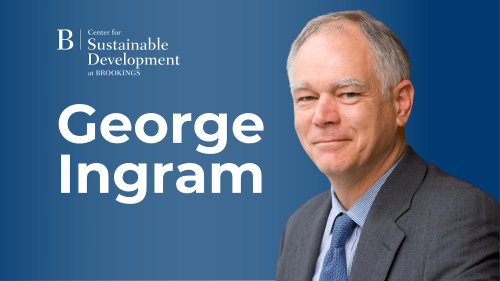President Obama’s national security strategy sets the stage for his administration to put a premium on global development cooperation. But, will the administration follow through?
The unveiling of the full strategy makes clear that U.S. global development policies will factor into each of the strategy’s four major pillars: security, prosperity, values and international order. Secretary of State Hillary Clinton spoke at Brookings yesterday about the strategy and despite talking about development at times during her remarks, the degree to which development is infused in the strategy was not particularly underscored. Given her track record of speaking passionately and extensively on development, I was surprised that she did not explicitly emphasize its importance.
The point in the national security strategy on being strong at home in order to lead globally is understandably a separate but important pillar for U.S. security and global leadership. Nevertheless, aspects from all the other key points in the strategy connect to America’s ability to promote global development and effectively assist people around the world. In the security section, development features primarily through the lens of stabilization, reconstruction and conflict prevention. In the prosperity section, the focus is on global public goods and investments in sustainable and long-term development. The values section references a slew of development principles and actions – as Clinton noted in her speech that “democracy, human rights and development are mutually reinforcing.” Lastly, the section on international order highlights the administration’s intent to renew U.S. multilateral development cooperation.
In recent months, the administration has publicly said favorable things on a broad range of development topics, such as the linking of climate change adaptation and development aid, of health threats and health systems, of sustainable results and a reasonable time horizon for investment, of programming decisions and evidence-based research, of capacity building and local ownership of development projects. Obama and his team have also demonstrated a high level of commitment to development issues on the international stage. However, the problem is not in the administration’s rhetoric.
The problem is that the U.S. needs to fundamentally reform its internal systems for managing and implementing its global development policies. This includes foreign assistance, but it also includes areas such as trade, agriculture, international finance and migration. As USAID Administrator Rajiv Shah has expressed, development is a discipline, but it is presently a discipline that is marred by U.S. policy incoherence largely because it is organizationally fragmented and structurally weak in lacking its own distinct clout in policy deliberations. The U.S. needs to put itself in a better position to support the broad range of development imperatives, including post-conflict reconstruction, the alleviation of poverty and human suffering, and the promotion of good governance and equitable economic growth. Only by doing this can the U.S. government effectively promote its values and security interests.
It is quite possible that the 2010 national security strategy will help open the door for the systemic elevation and reform of U.S. global development policies and operations. If Obama chooses to seriously head in that direction, the path is already somewhat illuminated:
At a strategic level, the development policy review ordered by the president last summer is rumored to be finished and its conclusions captured in a document. A draft of the document was leaked and then published earlier this month. Let’s hope the final version retains an approach to development that includes a deliberate policy, a more effective and partnership-oriented operation, and a new architecture that truly elevates development and coalesces development resources around a more focused set of objectives. The leaked draft called for a routine U.S. Global Development Strategy. As others and I have noted in the past, such a strategy could substantively expand on the national security strategy. It could do so in much the same way as the national military strategy. Having just completed consultative government-wide reviews of national security and development, the White House should aim to deliver the first U.S. Global Development Strategy in time for Obama’s much-anticipated speech on development at September’s United Nations summit.
At the operational level, many more changes are already underway, including a broader global health initiative, a forward-looking global hunger and food security initiative, the re-establishment and revitalization of USAID’s policy planning bureau and further reforms to improve the agency’s procurement, human resources and transparency.
Since day one, this administration has needed to redefine America’s global development cooperation. While its efforts in 2009 were detrimentally sluggish, the new national security strategy could breathe new life into the effort.
The Brookings Institution is committed to quality, independence, and impact.
We are supported by a diverse array of funders. In line with our values and policies, each Brookings publication represents the sole views of its author(s).



Commentary
Global Development in the U.S. National Security Strategy
May 28, 2010